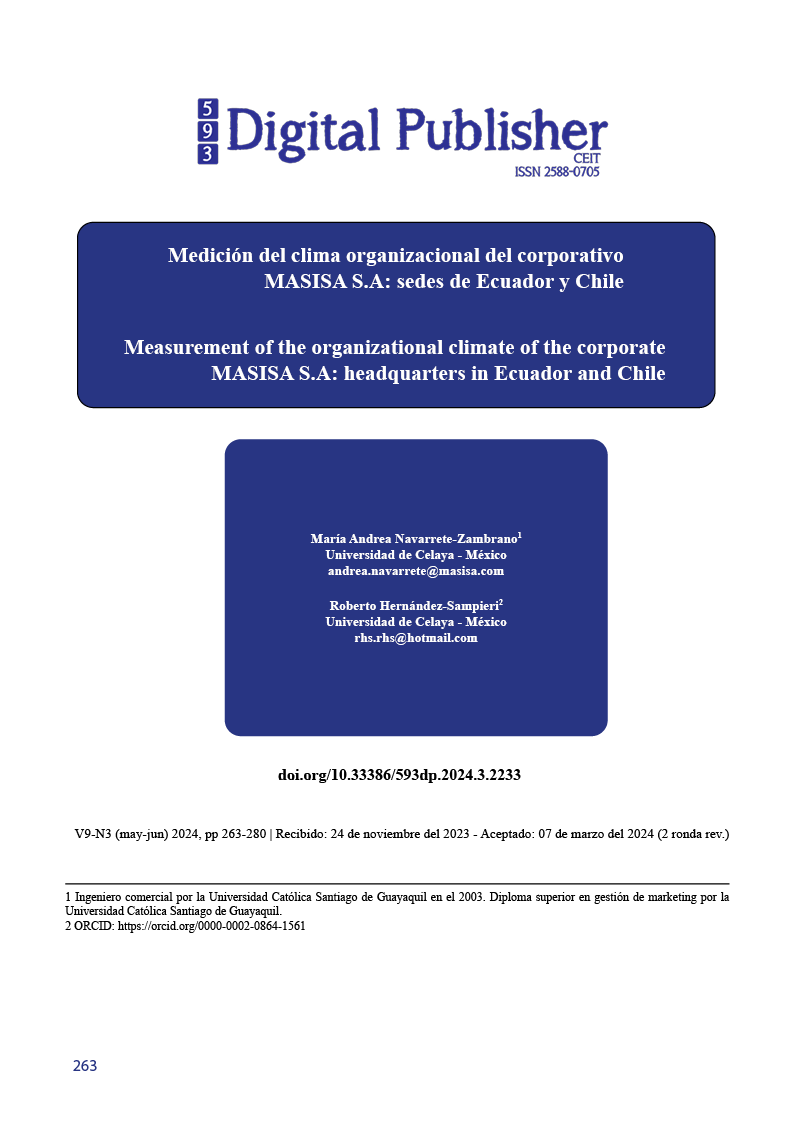Medición del clima organizacional del corporativo MASISA S.A: sedes de Ecuador y Chile
Contenido principal del artículo
Resumen
El estudio evalúa y compara el clima organizacional en las sedes de MASISA S.A. en Ecuador y Chile. Se aplicó el Instrumento del Clima Organizacional Psicológico a 100 empleados (28 en Ecuador y 72 en Chile) durante los meses de mayo, junio y julio de 2023. El instrumento consta de 12 dimensiones que abarcan aspectos como compañerismo, dirección, innovación, satisfacción laboral, entre otros. Los resultados indicaron que el clima organizacional en ambas sedes fue calificado como muy favorable, con una puntuación promedio de 4,82 en una escala de 5 puntos, sin diferencias significativas entre los dos países. Sin embargo, se observó una notoria diferencia en la dimensión "Percepción del esfuerzo sobre el desempeño", sugiriendo que en Ecuador hay una mayor valoración del esfuerzo y desempeño laboral en comparación con Chile. Estas disparidades pueden estar influenciadas por factores culturales o dinámicas laborales específicas. El estudio no solo aporta a la comprensión del clima organizacional en contextos sudamericanos, sino que, también es la primera vez que en estos dos países se emplea este instrumento de medición, representando un avance significativo para futuras investigaciones sobre el tema en la región.
Descargas
Detalles del artículo

Esta obra está bajo una licencia internacional Creative Commons Atribución-NoComercial-CompartirIgual 4.0.
1. Derechos de autor
Las obras que se publican en 593 Digital Publisher CEIT están sujetas a los siguientes términos:
1.1. 593 Digital Publisher CEIT, conserva los derechos patrimoniales (copyright) de las obras publicadas, favorece y permite la reutilización de las mismas bajo la licencia Licencia Creative Commons 4.0 de Reconocimiento-NoComercial-CompartirIgual 4.0, por lo cual se pueden copiar, usar, difundir, transmitir y exponer públicamente, siempre que:
1.1.a. Se cite la autoría y fuente original de su publicación (revista, editorial, URL).
1.1.b. No se usen para fines comerciales u onerosos.
1.1.c. Se mencione la existencia y especificaciones de esta licencia de uso.
Citas
Agudelo, R. D., Peña, P. A., Hoyos, C., y Jiménez, M. A. (2020). Clima organizacional y percepción de la calidad en una institución de salud de la ciudad de Manizales 2018 – 2019. Archivos de Medicina (Col), 20(2), 397-409. https://www.redalyc.org/journal/2738/273863770011/273863770011.pdf
Al-Dhaafri, H. S., Ameen, A. S., y Ashraf, R. (2021). Does employee relations climate mediate the effect of Islamic work ethics on organizational performance? Evidence from Qatar. Journal of Business Ethics, 169, 429-449.
Alhassan, Y. M., Akparep, J. Y., & Ngmenkpieo, F. (2022). Employee autonomy and employee creativity: The mediating role of intrinsic motivation. Open Journal of Leadership, 11(04), 356–369. https://doi.org/10.4236/ojl.2022.114019
Ashraf, R., Ashraf, M., Nisar, Q. A., & Hussain, S. T. (2021). Investigating the role of employee engagement, work engagement and job performance on educational service quality. Journal of Educational Administration.
Ataliç, H., Can, A. y Cantürk, N. (2016). Herzberg’s motivation- hygiene theory applied to high school teachers in Turkey. European Journal of Multidisciplinary Studies, 1(4), 90. https://www.researchgate.net/publication/318535121
Bravo-Díaz, Á., González-Murillo, G. A., Duque-Ceballos, J. L. (2018). Diseño de estrategias de mejoramiento a partir del diagnóstico de clima organizacional en una empresa distribuidora de combustibles y alimentos. ENTRAMADO, 14(1), 12–31. http://www.scielo.org.co/pdf/entra/v14n1/1900-3803-entra-14-01-12.pdf
Cardona, D., Lamadrid, J., y Brito, C. (2018). La gestión y dirección del talento humano desde el análisis sobre clima organizacional y sus dimensiones. Un estudio de caso. Aglala, 9(1), 154–176. https://doi.org/10.22519/22157360.1185
Cestau, D. (2020). Reconvertir: Fórmulas para rentabilizar a la pequeña y mediana empresa. Ediciones DelDragón.
Costumero, G. (2007). Relaciones en el Entorno de Trabajo. Ediciones Paraninfo, S.A. https://books.google.com.ec/books?id=MIUQwbkH5x0Cypg=PA242ydq=
Creswell, J. W., & Creswell, D. (2022). Research Design: Qualitative, quantitative, and Mixed Methods Approaches. SAGE Publications.
De la Cruz, I. (2014). Comunicación efectiva y trabajo en equipo. Ministerio de Educación y Formación Profesional de España.
Del Hoyo, M. (2018). Estrés Laboral. Instituto Nacional de Seguridad e Higiene en el Trabajo. https://www.sesst.org/wp-content/uploads/2018/08/estres-laboral-guia.pdf
Den Hartog, D. N., Boon, C., Verburg, R. M., y Croon, M. A. (2013). HRM, communication, satisfaction, and perceived performance: A cross-level test. Journal of Management, 39(6), 1637–1665. https://doi.org/10.1177/0149206312440118
Dias, S., García, S., y Yánez, A. (2022). síndrome de burnout y desempeño laboral del personal de salud durante la pandemia COVID-19. HorizEnferm,33(2),123-131. ttps://docs.bvsalud.org/biblioref/2022/09/1392366/3.pdf
El Sahili, F. (2016). Burnout: consecuencias y soluciones. El Manual Moderno S.A. https://books.google.com.ec/books?id=zrqsCgAAQBAJypg=PT20ydq=
Espinoza-Santeli, G., y Jiménez, A. (2019). Medición del clima organizacional con un enfoque de género en la Escuela Politécnica Nacional. Universidad & Empresa, 21(36), 261–284. https://revistas.urosario.edu.co/index.php/empresa/article/view/6778/6639
Gallardo, P. y Camacho, J. (2008). La motivación y el aprendizaje en educación (1ª ed.). Wanceulen Educación. https://books.google.com.ec/books?id=2t8ADAAAQBAJypg=PA9ydq=
García, M., Vesga, J. y Gómez, C. (2020). Clima organizacional: teoría y práctica. Universidad Católica de Colombia.
Gheitani, A., Imani, S., Seyyedamiri, N., & Foroudi, P. (2019). Mediating effect of intrinsic motivation on the relationship between Islamic work ethic, job satisfaction, and organizational commitment in banking sector. International Journal of Islamic and Middle Eastern Finance and Management, 12(1), 76–95. https://doi.org/10.1108/imefm-01-2018-0029
Gómez, M. M. (2006). Introducción a la metodología de la investigación científica. Argentina: Brujas. https://www.google.com.ec/books/edition/Introducci%C3%B3n_a_la_metodolog%C3%ADa_de_la_in/9UDXPe4U7aMC?hl=es-419&gbpv=0
Greenberg, J., y Baron, R. A. (2008). Behavior in Organizations: Understanding and Managing the Human Side of Work. Upper Saddle River, NJ: Pearson Prentice Hall.
Hackman, J., y Oldham, G. R. (1974). The Job Diagnostic Survey: An instrument for the diagnosis of jobs and the evaluation of job redesign projects. https://www.semanticscholar.org/paper/e47e797a026069ebce49ce95c7290406ed782ae9
Hernández Sampieri, R., y Méndez Valencia, D. (2012). Exploración factorial del clima y la cultura organizacional en el marco del modelo de los valores en competencia. Revista PsiqueMag,1(1), pp. 1 – 37. https://highered.mheducation.com/sites/dl/free/1456223968/1058642/06_ExploracionFactorialClima_Reporte.pdf
Hernández, R., Fernández, C. y Baptista, M. (2014). Metodología de la Investigación (6 ed). McGRAW-HILL / INTERAMERICANA EDITORES, S.A. DE C.V.
Hernández-Sampieri, R. (2019). Validación de un instrumento para medir las dimensiones del clima organizacional psicológico. Revista Raites, 5(10). http://www.itc.mx/ojs/index.php/raites/article/view/2017/1572
Huaire-Inacio, E. J., Marquina-Luján, R. J., Horna-Calderón, V. E., Llanos-Miranda, K. N., Herrera-Álvarez, Á. M., Rodríguez-Sosa, J., & Villamar-Romero, R. M. (2022b). Tesis fácil. El arte de dominar el método científico. Analéctica.
Kalhor, R., Khosravizadeh, O., Moosavi, S., Heidari, M., y Habibi, H. (2018). Role of organizational climate in job involvement: A way to develop the organizational commitment of nursing staff. Journal of Evidence-Based Integrative Medicine, 23, 2515690X18790726. https://doi.org/10.1177/2515690X18790726
Karatepe, O. M., & Tekinkus, M. (2006). The effects of work‐family conflict, emotional exhaustion, and intrinsic motivation on job outcomes of front‐line employees. International Journal of Bank Marketing, 24(3), 173–193. https://doi.org/10.1108/02652320610659021
Khalid, K., & Shoaib, A. (2019). Rewards, satisfaction and economic trends under nonlinear assumption. Journal of Asian Finance Economics and Business, 6(2), 287–298. http://koreascience.or.kr/article/JAKO201915658235033.page
Koles, B., & Kondath, B. (2015). Organizational climate in Hungary, Portugal, and India: a cultural perspective. AI & Society, 30(2), 251–259. https://doi.org/10.1007/s00146-013-0507-6
Koys, D. J., y DeCotiis, T. A. (1991). Inductive measures of psychological climate. Human Relations, 44(3), 265–285. https://journals.sagepub.com/doi/epdf/10.1177/001872679104400304
Litwin, G. H., y Stringer, R. A. (1968). The influence of organizational climate. Boston: Harvard University Press
Liu, Y., & Yu, Y. (2021). High performance work system, organizational citizenship behavior, and employee performance: A multilevel analysis. Personnel Review.
Liu, Y., Chen, C., y Peng, M. W. (2018). Human resource systems, employee creativity, and firm innovation: The moderating role of firm ownership. Journal of Management, 44(7), 2630-2652.
Lussier, R. y Achua, C. (2011). Liderazgo: Teoría, aplicación y desarrollo de habilidades. Cengage Learning Editores. https://www.ucipfg.com/Repositorio/MSCG/Enfasis-EEG/EEG-11/libro-general.pdf
Manjula, G. (2020). A study on organization climate an attribute to HRD. Ashok Yakkaldevi.
Marques, M. (2017). Estadistica Básica Un enfoque no paramétrico. Unam.
Masisa Corporativo (2023). https://corporativo.masisa.com/nuestra-empresa/
Meyer, J. P., Stanley, D. J., Herscovitch, L., & Topolnytsky, L. (2002). Affective, continuance, and normative commitment to the organization: A meta-analysis of antecedents, correlates, and consequences. Journal of Vocational Behavior, 61(1), 20-52.
Meyer, J. P., y Allen, N. J. (1991). A three-component conceptualization of organizational commitment. Human Resource Management Review, 1(1), 61–89. https://doi.org/10.1016/1053-4822(91)90011-z
Moslehpour, M., Altantsetseg, P., Mou, W., y Wong, W.-K. (2018). Organizational climate and work style: The missing links for sustainability of leadership and satisfied employees. Sustainability, 11(1), 125. https://doi.org/10.3390/su11010125
Mouro, C., y Duarte, A. (2021). Organisational climate and pro-environmental behaviours at work: The mediating role of personal norms. Frontiers in Psychology, 12. https://doi.org/10.3389/fpsyg.2021.635739
Nishii, L. H., Lepak, D. P., y Schneider, B. (2008). Employee attributions of the “why” of hr practices: Their effects on employee attitudes and behaviors, and customer satisfaction. Personnel Psychology, 61(3), 503–545. https://revistageon.unillanos.edu.co/index.php/geon/article/view/154/192
Palella, S. y Martins, F. (2012). Metodología de la Investigación Cuantitativa. Caracas, Venezuela: FEDUPEL. https://gc.scalahed.com/recursos/files/r161r/w23578w/w23578w.pdf
Pazmay, S., y Ortíz, Á. (2018). Clima Organizacional en las Industrias ecuatorianas de calzado. Cuadernos Latinoamericanos de Administración, 14(26). https://doi.org/10.18270/cuaderlam.v14i26.2606
Porter, L. W., y Lawer, E. E. (1965). Managerial Attitudes and Performance. Irwin: Homewood.
Ramos, P. (2012). Análisis de los riesgos psicosociales. El estrés y el síndrome de Burnout (2ª ed). Editorial ICB.
Raspa, P., López, D., y Moya, F. (2019). Síndrome de Burnout en trabajadores de empresas del sector comercio en la ciudad de Maracaibo, Venezuela, 40(43). https://www.revistaespacios.com/a19v40n43/a19v40n43p08.pdf
Rehman, U., y Shahnawaz, M. G. (2018). Machiavellianism, job autonomy, and counterproductive work behaviouramong Indian managers. Revista de Psicología Del Trabajo y de Las Organizaciones, 34(2), 083–088. https://doi.org/10.5093/jwop2018a10
Robbins, S. P., Judge, T. A., y Judge, T. (2017). Comportamiento organizacional. España: Pearson Educación.
Rodríguez, E. (2016). El clima organizacional presente en una empresa de servicio. Revista Educación en Valores, 1(5), 3-18. http://servicio.bc.uc.edu.ve/multidisciplinarias/educacion-en-valores/v1n25/art01.pdf
Rodríguez-Domínguez, C. y Domínguez-Salas, S. (2022). Guía para la elaboración de trabajos fin de grado y trabajos fin de máster en psicología y ciencias afines. https://dialnet.unirioja.es/servlet/libro?codigo=869425&orden=0&info=open_link_libro
Ruiz, O. (2017). Liderazgo. Editorial Alfil, S. A. de C. V. https://es.scribd.com/document/488765924/Libro-Liderazgo
Saldaña, A. (2018). La relación entre las dimensiones del clima organizacional en empresas de la región Laja-Bajío de México [Disertación doctoral no publicada]. Universidad de Celaya.
Schneider, B., Ehrhart, M. G., & Macey, W. H. (2013). Organizational climate and culture. Annual Review of Psychology, 64(1), 361–388. https://doi.org/10.1146/annurev-psych-113011-143809
Segredo, A. (2013). Propuesta de instrumento para el estudio del clima organizacional. Educación médica 17 (3). https://www.medigraphic.com/pdfs/correo/ccm-2013/ccm133n.pdf
Siegrist, J., Starke, D., Chandola, T., Godin, I., Marmot, M., Niedhammer, I., y Peter, R. (2004). The measurement of effort–reward imbalance at work: European comparisons. Social Science & Medicine (1982), 58(8), 1483–1499. https://doi.org/10.1016/s0277-9536(03)00351-4
Smith, D. B., & Shields, J. (2013). Factors related to social service workers’ job satisfaction: Revisiting herzberg’s motivation to work. Administration in Social Work, 37(2), 189–198. https://doi.org/10.1080/03643107.2012.673217
Strand, V. C., & Dore, M. M. (2009). Job satisfaction in a stable state child welfare workforce: Implications for staff retention. Children and Youth Services Review, 31(3), 391–397. https://doi.org/10.1016/j.childyouth.2008.09.002
Tomás-Sábado, J. (2010). Fundamentos de bioestadística y análisis de datos para enfermería. Univ. Autónoma de Barcelona.
Tortolero, H., y Trejo, T. (2018). La motivación laboral en la dirección de desarrollo estudiantil, de la Universidad de Carabobo, Municipio Naguanagua. Universidad de Carabobo.
Velázquez, Á. (2007). Tecnologías del software: Seminario de investigación e innovación en tecnologías del software. Librería-Editorial Dykinson.
Velosa, C. (2019). Relación entre las dimensiones del clima organizacional en una universidad pública colombiana [Disertación doctoral no publicada]. Universidad de Celaya.
Vidal, V. (2019). El estrés laboral: análisis y prevención. Zaragoza, Prensas de la Universidad de Zaragoza.
Vijay, G. (2015). Research approach: an overview. Golden Reserach Thoughts, 4 (8). 1-8. https://www.researchgate.net/publication/273352276
Zhao, H., Wayne, S. J., Glibkowski, B. C., & Bravo, J. (2007). The impact of psychological contract breach on work-related outcomes: A meta-analysis. Personnel Psychology, 60(3), 647-680.



